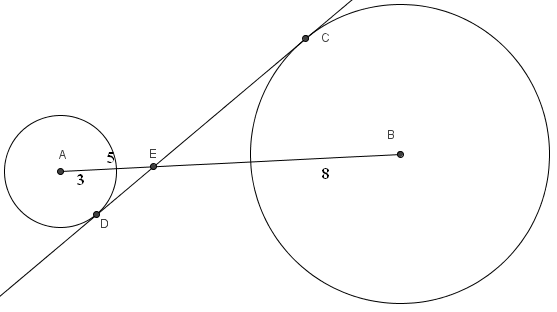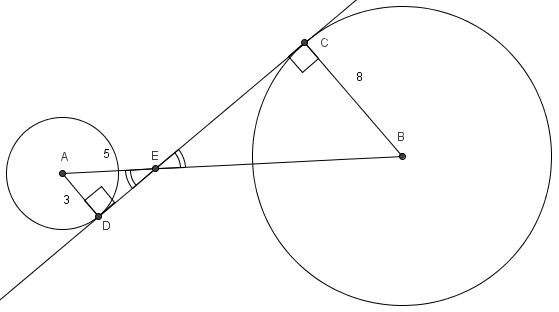Difference between revisions of "2006 AMC 12A Problems/Problem 16"
(→See also) |
|||
| Line 10: | Line 10: | ||
[[Image:2006_AMC12A-16a.png]] | [[Image:2006_AMC12A-16a.png]] | ||
| − | <math>\angle AEC</math> and <math>\angle BED</math> are [[vertical angles]] so they are [[congruent (geometry) | congruent]], as are [[angle]]s <math>\angle | + | <math>\angle AEC</math> and <math>\angle BED</math> are [[vertical angles]] so they are [[congruent (geometry) | congruent]], as are [[angle]]s <math>\angle ADE</math> and <math>\angle BCE</math> (both are [[right angle]]s because the radius and [[tangent line]] at a point on a circle are always [[perpendicular]]). Thus, <math>\triangle ACE \sim \triangle BDE</math>. |
| − | By the [[Pythagorean Theorem]], [[line segment]] <math>DE = 4</math>. The sides are [[proportion]]al, so <math>\frac{ | + | By the [[Pythagorean Theorem]], [[line segment]] <math>DE = 4</math>. The sides are [[proportion]]al, so <math>\frac{DE}{AD} = \frac{CE}{BC} \Rightarrow \frac{4}{3} = \frac{CE}{8}</math>. This makes <math>CE = \frac{32}{3}</math> and <math>CD = CE + DE = 4 + \frac{32}{3} = \frac{44}{3} \Longrightarrow \mathrm{B}</math>. |
== See also == | == See also == | ||
Revision as of 16:46, 26 January 2014
- The following problem is from both the 2006 AMC 12A #16 and 2006 AMC 10A #23, so both problems redirect to this page.
Problem
Circles with centers ![]() and
and ![]() have radii 3 and 8, respectively. A common internal tangent intersects the circles at
have radii 3 and 8, respectively. A common internal tangent intersects the circles at ![]() and
and ![]() , respectively. Lines
, respectively. Lines ![]() and
and ![]() intersect at
intersect at ![]() , and
, and ![]() . What is
. What is ![]() ?
?
![]()
Solution
![]() and
and ![]() are vertical angles so they are congruent, as are angles
are vertical angles so they are congruent, as are angles ![]() and
and ![]() (both are right angles because the radius and tangent line at a point on a circle are always perpendicular). Thus,
(both are right angles because the radius and tangent line at a point on a circle are always perpendicular). Thus, ![]() .
.
By the Pythagorean Theorem, line segment ![]() . The sides are proportional, so
. The sides are proportional, so ![]() . This makes
. This makes ![]() and
and ![]() .
.
See also
| 2006 AMC 12A (Problems • Answer Key • Resources) | |
| Preceded by Problem 15 |
Followed by Problem 17 |
| 1 • 2 • 3 • 4 • 5 • 6 • 7 • 8 • 9 • 10 • 11 • 12 • 13 • 14 • 15 • 16 • 17 • 18 • 19 • 20 • 21 • 22 • 23 • 24 • 25 | |
| All AMC 12 Problems and Solutions | |
| 2006 AMC 10A (Problems • Answer Key • Resources) | ||
| Preceded by Problem 22 |
Followed by Problem 24 | |
| 1 • 2 • 3 • 4 • 5 • 6 • 7 • 8 • 9 • 10 • 11 • 12 • 13 • 14 • 15 • 16 • 17 • 18 • 19 • 20 • 21 • 22 • 23 • 24 • 25 | ||
| All AMC 10 Problems and Solutions | ||
The problems on this page are copyrighted by the Mathematical Association of America's American Mathematics Competitions. 











